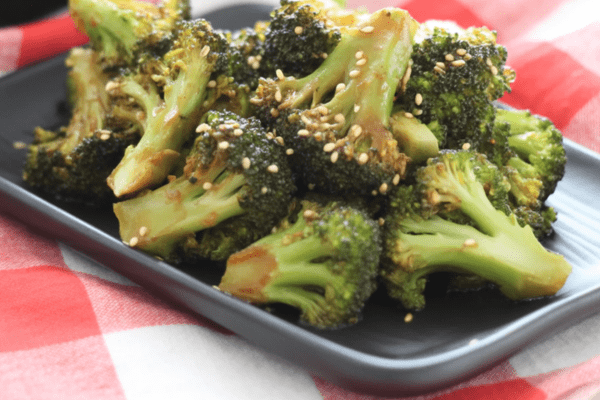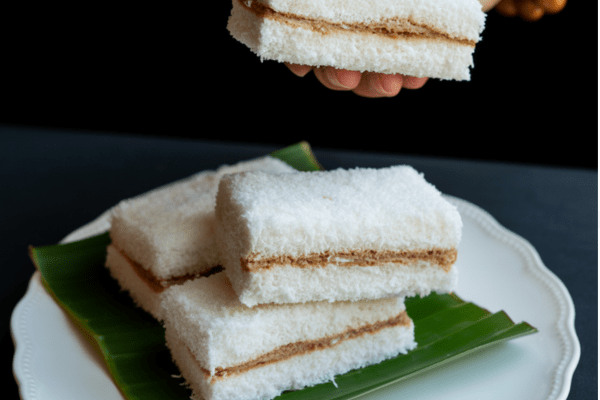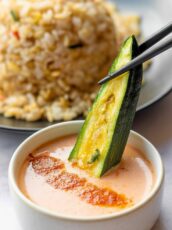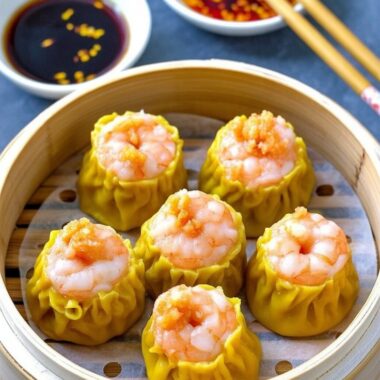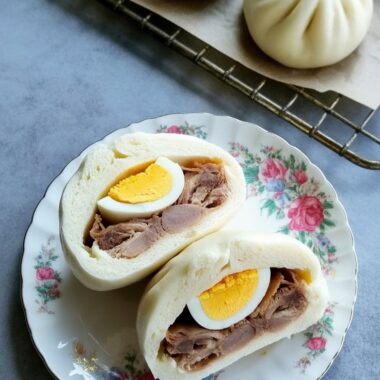This Vietnamese Caramelized Pork Belly, or Thịt Kho Tàu, is a deeply comforting dish—tender, flavorful pork belly slowly simmered in a savory-sweet caramel sauce. It’s the kind of food that wraps you up in warmth, especially when paired with a bowl of hot, fluffy rice. Add some boiled eggs, and it’s a complete soul-satisfying meal that’s beloved across generations in Vietnamese homes.
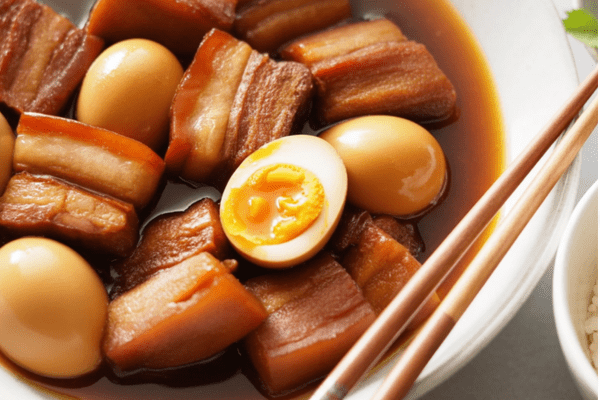
What is Thịt Kho Tàu?
At its heart, Thịt Kho Tàu is a slow-braised pork belly dish made with caramelized sugar, fish sauce, and often, hard-boiled eggs. You’ll find it on many Vietnamese family tables—some simply call it thịt kho, and when eggs are added, it becomes thịt kho trứng. In the southern regions of Vietnam, this eggy version is a must during Lunar New Year celebrations.
Though every household has its own spin, the dish is common across the country—with a few notable regional twists:
- Northern-style: Typically saltier, less saucy, often made with plain water, and the pork is cut into smaller chunks.
- Southern-style: Leans sweeter, has a generous amount of sauce, often uses coconut water, and the pork belly pieces are cut larger.
The version I’m sharing today is a balance of both—rich and caramelized with just the right touch of sweetness, perfect for spooning over rice or dunking with a hunk of bread.
The Secret’s in the Braise
In this dish, pork belly simmers slowly in a caramelized sauce until it turns beautifully bronze, tender enough to fall apart at the nudge of a spoon, and infused with all the salty-sweet depth that makes it such a favorite.

Best Cut of Pork to Use
Hands down, pork belly is the way to go here. Its fat renders into the sauce, keeping the meat moist and luscious. I know some folks prefer leaner cuts like pork shoulder, and that works too—but it won’t have the same melt-in-your-mouth quality. When I make this dish, I try to pick a pork belly piece with a good balance of meat and fat so it doesn’t turn out too greasy.
How to Make the Caramel Sauce
Now this is where you want to pay attention. The caramel sauce (or nước màu, as it’s known in Vietnam) is what gives the dish its gorgeous deep color and rich, layered flavor. And yes, it can be a little tricky the first time, but once you get the hang of it, it’s actually quite simple.
You’ll just need plain white or golden granulated sugar (not brown sugar). Vietnamese home cooks don’t usually use brown sugar here. Melt the sugar over medium heat with a splash of water, let it darken to a deep amber—but not burnt—then quickly add water to stop the cooking. Be careful with the steam when the water hits the hot caramel—it splatters fast.
If you prefer a lighter or darker color in the final dish, you can adjust the amount of caramel sauce you use. Don’t skip this step—it’s what makes thịt kho shine.

About the Eggs (Optional but Delicious)
I personally love this dish with eggs. Hard-boiled eggs soak up all the savory caramel goodness and become flavor bombs. You can use chicken eggs or duck eggs, depending on what’s available.
If you want to go the extra mile, there’s another version where you fry the boiled eggs until the outside is blistered and golden before simmering them with the pork. It’s next-level tasty, but honestly, it’s also a bit of a mess—eggs popping, oil splattering. Totally worth trying if you’re feeling adventurous.
How to Store Leftovers
One of the best things about thịt kho tàu is that it stores beautifully. You can refrigerate the pork (and the sauce) in an airtight container for up to a week. The flavors actually deepen over time, making the next-day version even better.
Want to freeze it? Absolutely! Just skip the eggs when freezing. The pork and sauce freeze well for 1–2 weeks. When you’re ready to eat, reheat gently on the stovetop and toss in freshly boiled eggs if you like.
Serving Suggestions
This dish was made to be eaten with steamed jasmine rice—it soaks up the sauce beautifully and balances the richness of the pork. Sometimes I serve it with sticky rice, which is also a classic pairing in Vietnam.
Feeling a bit creative? Thinly slice the pork belly and eggs, stuff them inside a baguette, drizzle with some of that luscious sauce, and finish with a crack of black pepper. Just like that, you’ve got a killer banh mi.
Vietnamese Caramelized Pork

Vietnamese caramelized pork belly with eggs (thit kho tau) is a beloved comfort food in many Vietnamese families. Pork belly is gently braised until it develops a rich caramel color and becomes tender and flavorful.
Ingredients
- 2 lbs pork belly
- 4 garlic cloves, crushed
- 3 shallots, crushed
- 1 teaspoon salt
- 1/2 teaspoon pepper
- 2 tablespoons granulated sugar
- 3 tablespoons water, divided
Cooking oil
- 3-4 tablespoons fish sauce (adjust to taste)
- 3 cups fresh coconut juice (about 2 coconuts)
- 6-8 eggs (adjust to your preference)
Instructions
- Slice pork belly into 1-inch thick (or slightly thicker) pieces. In a bowl, toss the pork with crushed garlic, shallots, salt, and pepper. Set aside at room temperature for 10–20 minutes.
- In a small saucepan, add 2 tablespoons of sugar and 2 tablespoons of water. Bring to a boil until the sugar dissolves completely. Reduce the heat to medium and continue to simmer. The mixture will bubble and gradually change color from clear to yellow and then to a deeper caramel hue. When it reaches a honey color, reduce the heat slightly. Keep a close eye on it—once it turns a dark caramel color, turn off the heat and carefully add 1 tablespoon of water. Swirl the saucepan or stir to combine, then remove from the stove and set aside.
- Heat a heavy-bottomed pot over medium heat with a small amount of cooking oil. When hot, add the pork belly along with the crushed garlic and shallots, and pour in the caramel sauce. Stir to coat the pork with the sauce, then add fish sauce. Continue stirring and cooking.
- Once the pork is no longer pink on the outside, add coconut juice to cover the meat. Bring it to a boil and skim off any foam. Reduce to a simmer.
- Cover the pot with the lid slightly ajar and simmer until the pork is nearly tender (around 75–80 minutes). Stir occasionally for even cooking if desired.
- While the pork is simmering, boil the eggs until just about hard-boiled. Cool them in cold water, then peel.
- When the pork is nearly tender, add the eggs, making sure they are submerged in the braising liquid. Cover and simmer for about 10 more minutes.
- Transfer the pork belly and eggs with the sauce to a shallow serving dish. Serve hot with white rice.
Notes
- This dish can also be enjoyed with steamed sticky rice for breakfast or lunch, which is a traditional way to serve it.
- The pork (without eggs) freezes well. Store in Ziploc freezer bags with the sauce for up to 2 weeks. Thaw and reheat on the stove, adding eggs if desired.
- To adjust the color of the dish, use more or less caramel sauce. If coconut juice is unavailable, plain water with added sugar can be used as a substitute.
- If making caramel sauce is too intimidating, dark soy sauce can be used as an alternative.
- There’s also a variation where boiled eggs are fried until golden and blistered before adding to the pork. This gives a delicious twist, though it can be messy due to splattering.
Nutrition Information:
Yield: 4 Serving Size: 1Amount Per Serving: Calories: 1108Total Fat: 78gSaturated Fat: 39gTrans Fat: 0gUnsaturated Fat: 36gCholesterol: 563mgSodium: 2350mgCarbohydrates: 31gFiber: 7gSugar: 21gProtein: 69g
Asianplated.com, occasionally offers nutritional information for recipes contained on this site. This information is provided as a courtesy and is an estimate only. This information comes from online calculators. Although allchickenrecipes.com attempts to provide accurate nutritional information, these figures are only estimates.
Final Thoughts
If you’re looking for a comforting, full-flavored dish to cozy up with, Vietnamese Caramelized Pork is it. Whether you’re making it for a weeknight dinner or a special family meal, it always brings warmth to the table.
Let it simmer slow, enjoy the aromas that fill your kitchen, and serve it up with a generous scoop of rice. That’s how I like to enjoy it—and I think you’ll love it too.
Try other recipes:

